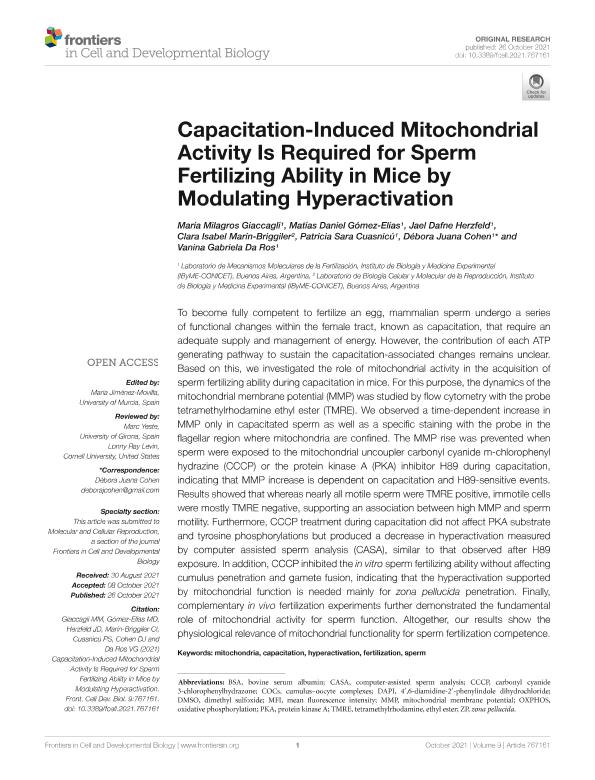Artículo
Capacitation-induced mitochondrial activity Is required for sperm fertilizing ability in mice by modulating hyperactivation
Giaccagli, Maria Milagros ; Gómez Elías, Matías Daniel
; Gómez Elías, Matías Daniel ; Herzfeld, Jael Dafne; Marin Briggiler, Clara Isabel
; Herzfeld, Jael Dafne; Marin Briggiler, Clara Isabel ; Cuasnicu, Patricia Sara
; Cuasnicu, Patricia Sara ; Cohen, Debora Juana
; Cohen, Debora Juana ; Da Ros, Vanina Gabriela
; Da Ros, Vanina Gabriela
 ; Gómez Elías, Matías Daniel
; Gómez Elías, Matías Daniel ; Herzfeld, Jael Dafne; Marin Briggiler, Clara Isabel
; Herzfeld, Jael Dafne; Marin Briggiler, Clara Isabel ; Cuasnicu, Patricia Sara
; Cuasnicu, Patricia Sara ; Cohen, Debora Juana
; Cohen, Debora Juana ; Da Ros, Vanina Gabriela
; Da Ros, Vanina Gabriela
Fecha de publicación:
10/2021
Editorial:
Frontiers Media
Revista:
Frontiers in Cell and Developmental Biology
ISSN:
2296-634X
Idioma:
Inglés
Tipo de recurso:
Artículo publicado
Clasificación temática:
Resumen
To become fully competent to fertilize an egg, mammalian sperm undergo a series of functional changes within the female tract, known as capacitation, that require an adequate supply and management of energy. However, the contribution of each ATP generating pathway to sustain the capacitation-associated changes remains unclear. Based on this, we investigated the role of mitochondrial activity in the acquisition of sperm fertilizing ability during capacitation in mice. For this purpose, the dynamics of the mitochondrial membrane potential (MMP) was studied by flow cytometry with the probe tetramethylrhodamine ethyl ester (TMRE). We observed a time-dependent increase in MMP only in capacitated sperm as well as a specific staining with the probe in the flagellar region where mitochondria are confined. The MMP rise was prevented when sperm were exposed to the mitochondrial uncoupler carbonyl cyanide m-chlorophenyl hydrazine (CCCP) or the protein kinase A (PKA) inhibitor H89 during capacitation, indicating that MMP increase is dependent on capacitation and H89-sensitive events. Results showed that whereas nearly all motile sperm were TMRE positive, immotile cells were mostly TMRE negative, supporting an association between high MMP and sperm motility. Furthermore, CCCP treatment during capacitation did not affect PKA substrate and tyrosine phosphorylations but produced a decrease in hyperactivation measured by computer assisted sperm analysis (CASA), similar to that observed after H89 exposure. In addition, CCCP inhibited the in vitro sperm fertilizing ability without affecting cumulus penetration and gamete fusion, indicating that the hyperactivation supported by mitochondrial function is needed mainly for zona pellucida penetration. Finally, complementary in vivo fertilization experiments further demonstrated the fundamental role of mitochondrial activity for sperm function. Altogether, our results show the physiological relevance of mitochondrial functionality for sperm fertilization competence.
Palabras clave:
CAPACITATION
,
FERTILIZATION
,
HYPERACTIVATION
,
MITOCHONDRIA
,
SPERM
Archivos asociados
Licencia
Identificadores
Colecciones
Articulos(IBYME)
Articulos de INST.DE BIOLOGIA Y MEDICINA EXPERIMENTAL (I)
Articulos de INST.DE BIOLOGIA Y MEDICINA EXPERIMENTAL (I)
Citación
Giaccagli, Maria Milagros; Gómez Elías, Matías Daniel; Herzfeld, Jael Dafne; Marin Briggiler, Clara Isabel; Cuasnicu, Patricia Sara; et al.; Capacitation-induced mitochondrial activity Is required for sperm fertilizing ability in mice by modulating hyperactivation; Frontiers Media; Frontiers in Cell and Developmental Biology; 9; 10-2021; 1-13
Compartir
Altmétricas



